
Leather is a durable and flexible material created by tanning animal rawhide and skins. The most common raw material is cattle hide. It can be produced at manufacturing scales ranging from artisan to modern industrial scale.

A handicraft, sometimes more precisely expressed as artisanal handicraft or handmade, is any of a wide variety of types of work where useful and decorative objects are made completely by hand or by using only simple tools. It is a traditional main sector of craft and applies to a wide range of creative and design activities that are related to making things with one's hands and skill, including work with textiles, moldable and rigid materials, paper, plant fibers, etc. One of the world's oldest handicraft is Dhokra; this is a sort of metal casting that has been used in India for over 4,000 years and is still used. In Iranian Baluchistan, women still make red ware hand made pottery with dotted ornaments much similar to the 5000 year old pottery tradition of Kalpurgan, an archaeological site near the village. Usually, the term is applied to traditional techniques of creating items that are both practical and aesthetic. Handicraft industries are those that produce things with hands to meet the needs of the people in their locality. Machines are not used.
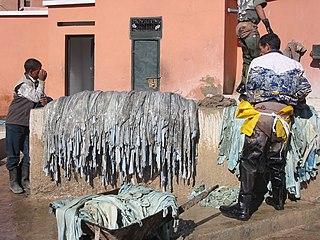
Tanning is the process of treating skins and hides of animals to produce leather. A tannery is the place where the skins are processed.

Jute is a long, soft, shiny bast fiber that can be spun into coarse, strong threads. It is produced primarily from plants in the genus Corchorus, which was once classified with the family Tiliaceae. The primary source of the fiber is Corchorus olitorius, but it is considered inferior to Corchorus capsularis. "Jute" is the name of the plant or fiber used to make burlap, hessian or gunny cloth.
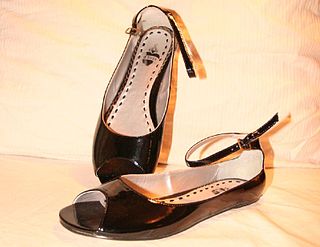
Patent leather is a type of coated leather that has a high-gloss finish. The coating process was introduced to the United States and improved by inventor Seth Boyden, of Newark, New Jersey, in 1818, with commercial manufacture beginning September 20, 1819. Boyden's process used a lacquer coating that was based on linseed oil. Modern patent leather usually has a plastic coating.
A hide or skin is an animal skin treated for human use. The word "hide" is related to the German word "Haut" which means skin. The industry defines hides as "skins" of large animals e.g. cow, buffalo; the skins refer to "skins" of smaller animals: goat, sheep, deer, pig, fish, alligator, snake, etc. Common commercial hides include leather from cattle and other livestock animals, buckskin, alligator skin and snake skin. All are used for shoesclothes, leather bags, belts, or other fashion accessories. Leather is also used in cars, upholstery, interior decorating, horse tack and harnesses. Skins are sometimes still gathered from hunting and processed at a domestic or artisanal level but most leather making is now industrialized and large-scale. Various tannins are used for this purpose. Hides are also used as processed chews for dogs or other pets.

Shell cordovan is a type of leather commonly used in high-end shoemaking. Cordovan is an equine leather made from the fibrous flat connective tissue beneath the hide on the rump of the horse. The leather derives its name from the city of Cordoba, Spain, where it was first produced by the Visigoths in the seventh century, and later also by the Moors. It is a difficult and expensive leather to make, and in the late 19th and early 20th century was mostly used for razor strops to sharpen razors in barber shops. More recently it has been increasingly used for shoes, wallets, and watch straps due to its aesthetic qualities and exceptional durability. Shell cordovan has a unique non-creasing characteristic. Because it is made of connective tissue, it is smooth and lacks the pebbled effect of leather derived from animal skin.

Chamois leather is a type of porous leather, traditionally the skin of the chamois, a type of European mountain goat, but today made almost exclusively from the flesh split of a sheepskin.

Goatskin refers to the skin of a goat, which by long term usage, is denoted by the term Morocco leather. Kidskin, used for gloves, shoes and other accessories, is traditionally goatskin, although other leathers such as sheep and kangaroo can be used to make kid.

Ostrich leather is the result of tanning skins taken from African ostriches farmed for their feathers, skin and meat. The leather is distinctive for its pattern of bumps or vacant quill follicles, ranged across a smooth field in varying densities. It requires an intricate, specialised and expensive production process making its aesthetic value costly.
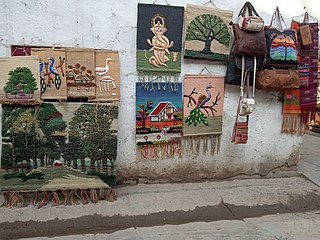
Nepalese handicraft history can be traced back to the Stone Age when human beings were inadequate of tools of every things. The history of artistic handicrafts only began during the 5th century AD, when different religions began to form their bases among the people of Nepal. Hence we see a lot of religious influence on Nepalese handicrafts.

Morocco leather is a soft, pliable form of leather widely used for gloves and the uppers of ladies' shoes and men's low cut shoes, but traditionally associated with bookbindings, wallets, linings for fine luggage, and the like.

A club chair is a type of armchair, usually covered in leather. It was created and made in France. Before it came to be known under its current name, it first appeared as the fauteuil confortable, the "comfortable armchair". It was given this name to distinguish it from the fauteuil de style, which had straighter lines and was less enveloping.

Amar Kutir, once a place of refuge for independence movement activists has been turned into a cooperative society for the promotion of arts and crafts. It is located on the banks of the Kopai River, about 15 kilometres (9.3 mi) from Santiniketan in Birbhum district in the Indian state of West Bengal.
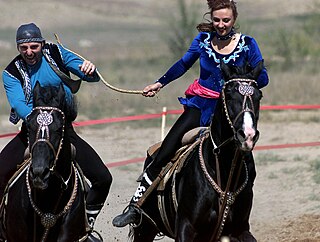
Kazakh clothing, worn by the Kazakh people, is often made of materials suited to the region's extreme climate and the people's nomadic lifestyle. It is commonly decorated with elaborate ornaments made from bird beaks, animal horns, hooves and feet. Although contemporary Kazakhs usually wear Western dress, the Turkic people wear more traditional clothing for holidays and special occasions.

Bagh print is a traditional Indian handicraft originating in Bagh, Dhar district of Madhya Pradesh, India. The process is characterised by hand printed wood block relief prints with naturally sourced pigments and dyes. Bagh print fabric motifs are typically geometric, paisley, or floral compositions dyed with vegetable colours of red and black over a white background, and is a popular textile printing product. Its name is derived from the village Bagh located on the banks of the Bagh River.
Mangalagiri Sarees and Fabrics are produced by performing handicraft weaving in Mangalagiri, a town in Guntur district of the Indian state of Andhra Pradesh. It was registered as one of the handicraft in the geographical indication from Andhra Pradesh by Geographical Indications of Goods Act, 1999. The Mangalagiri fabric is produced by weaving with the help of pitlooms from combed yarn by warp and woof interlacing. The fabric then undergoes the process of dyeing. The Nizam design is another characteristic of the fabric.

Madurkathi mats, or madur, are mats woven in West Bengal from a reed called madur kottir, or madurkathi, a sedge of the family Cyperaceae. Madur mat-making is a long-standing tradition, centred on the Medinipur district, and is an important part of the rural economy. The mats are woven mainly by weavers of the Mahishya caste, and predominantly by women. This cottage industry contributes significantly to village household income.
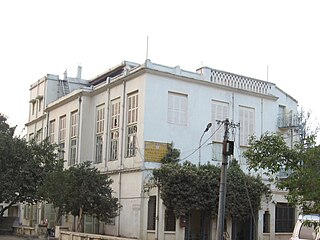
Palli Samgathana Vibhaga, of Visva-Bharati University, was established at Sriniketan in 1922, by the Nobel laureate Rabindranath Tagore. Leonard Knight Elmhirst was its first Director.



















